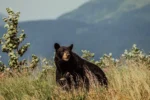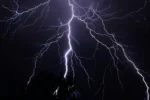How to avoid insect stings while hiking
This post may contain affiliate links. This means that we may receive a small commission from purchases through those links. Read more in our affiliate disclosure.
Hiking connects us with nature, but insects often interfere. This article covers why insects are attracted to humans, and offers practical solutions for hikers to deal with mosquitos, bees, wasps, and other stinging insects.
Wear light clothing, and avoid bright colors, floral patterns as well as scented products in order to avoid attracting mosquitos and bees. When encountering insects that sting defensively, like wasps, bees and hornets, stay calm, move slowly, and give the insect space. Avoid and move away from any nests. Youc an wear long sleeves or even hats with insect screens for additional protection, or use insect repellants – but if you choose to do so, be mindful to not poison aquatic habitats.
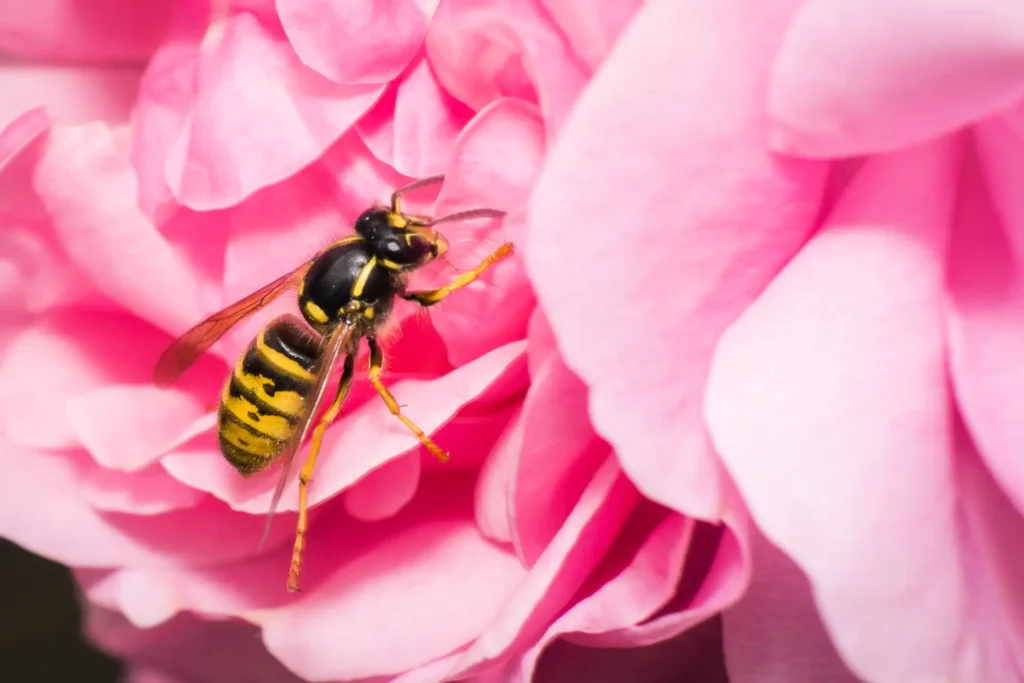
We’ll cover the various kinds of insects and the strategies to deal with each down below; but let’s first look at the overall guidelines:
- Introduction
- Why Insects Find You Attractive
- General Strategies for Insect Protection
- How to deal with different Kinds of Insects
- Mosquitos
- How to deal with Bees on Hikes
- Bumblebees
- Wasps
- Hornets
- Hover flies: Harmless Impostors
- Horseflys: Mean blood suckers
- Environmental Considerations
- The Ecological Role of Insects and Responsible Insect Repellent Use
- Avoid Harming Aquatic Life and Ecosystems
- Conclusion
Why Insects Find You Attractive
Insects are drawn to several of our natural physiological characteristics and activities:
Movement
Insects are adept at detecting movement. As you hike, your movement disturbs the air and sends signals to these insects, making you an easy target. Mosquitoes, in particular, use vision to locate moving targets from a distance.
Body Heat
Our body heat is another significant attractant for insects like mosquitoes. They are equipped with heat sensors that allow them to detect warm-blooded animals from a distance. This thermal signature is particularly strong when we exert ourselves during hiking, increasing our body temperature and making us more visible to mosquitoes.
Bacteria and Chemical Scents on Skin
The skin microbiome, a complex ecosystem of bacteria living on our skin, plays a crucial role in how insects perceive us. Different types of bacteria produce various chemical scents, some of which are more attractive to insects than others. Mosquitoes, for instance, are known to be drawn to certain chemical compounds emitted through our skin. By taking a shower with unscented products before your hike, you can make yourself smell less tasty.
Food
Some insects are attracted not to you, but to the snacks you brought. Wasps enjoy meat in early summer and sweets in late summer, and will come looking for your (especially the strong-smelling) foods. You can avoid this by packing your meals in airtight containers, and not leaving them out for extended periods of time.
General Strategies for Insect Protection
By employing a combination of strategies, you can significantly reduce the likelihood of insect bites and the discomfort they cause.
Appropriate Clothing for Insect Prevention
Choosing the right clothing is one of the most effective ways to deter insects. Long sleeves and pants made from tightly woven fabrics offer a physical barrier that insects can’t penetrate. Look for lightweight and breathable materials to stay comfortable. Tucking your pants into your socks and your shirt into your pants can also prevent insects from crawling inside your clothing.
If you hike in especially insect-dense areas, you can use hats with insect screens provide an extra layer of protection, especially for your face and neck, which are often more exposed.
The color of your clothing can also play a role in attracting or repelling insects. Bright colors and floral patterns can attract bees and wasps, while dark colors tend to attract mosquitoes. Light-colored clothing is generally less attractive to many types of insects and can help keep them at bay.
How to deal with different Kinds of Insects
Different insect species have very diverse behaviors and reasons to sting you. Let’s go over some common types of insects you might encounter and strategies to deal with them.
Mosquitos
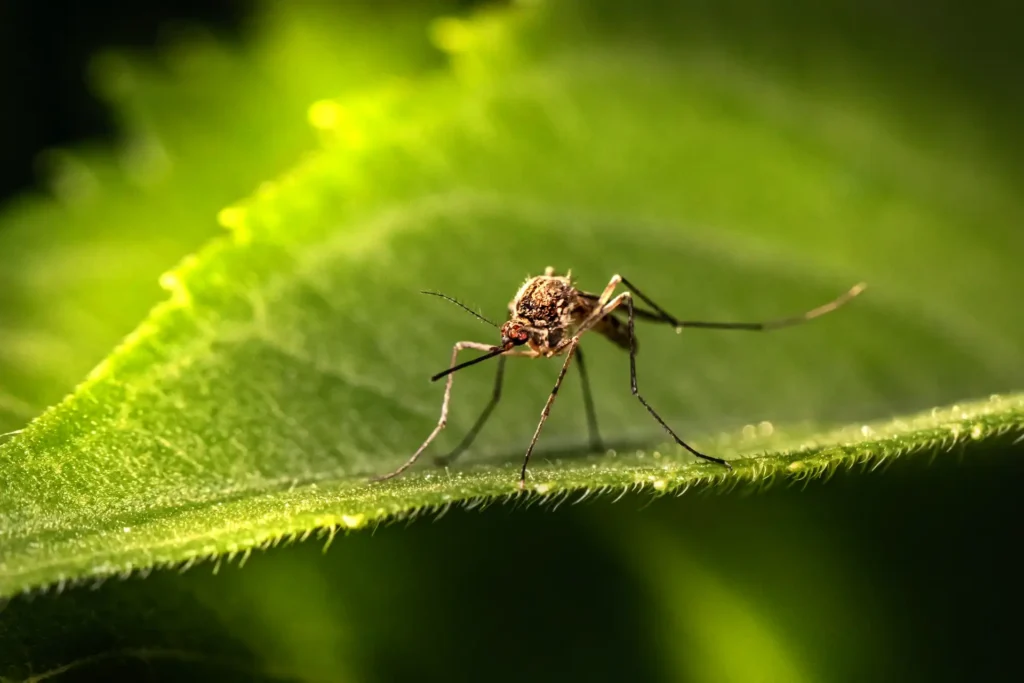
Mosquitos are probably the most annoying insect due to their biting habits and potential to transmit diseases.
- Appearance: Mosquitos are easily recognizable by their buzzing sound, slender bodies, and long proboscis used for feeding.
- Behavior and Attraction to Humans: They are drawn to carbon dioxide, body heat, and certain body odors. Mosquitos are particularly active at dawn and dusk and breed in standing water.
- How to avoid mosquitos:
- Use Repellents: Apply EPA-registered insect repellents containing DEET, picaridin, IR3535, or oil of lemon eucalyptus. Reapply as directed, especially after sweating or swimming.
- Wear Protective Clothing: Long sleeves, pants, and hats can provide a barrier against bites. Clothing treated with permethrin offers additional protection.
- Limit Outdoor Activity During Peak Hours: Avoid being outside when mosquitos are most active, typically at dawn and dusk.
- Stay away from Breeding Sites: Standing water is mosquito breeding ground, so set up camp away from shallow lakes, swamps and puddles.
- How to deal with bites:
- Do Not Scratch: Scratching can cause the bite to become more inflamed.
- Use Anti-itch Creams: Over-the-counter hydrocortisone or calamine lotion can alleviate itching.
- Watch for Allergic Reactions: In rare cases, mosquito bites can cause a severe allergic reaction. Seek medical attention if you experience symptoms like difficulty breathing or swelling of the face or throat.
How to deal with Bees on Hikes
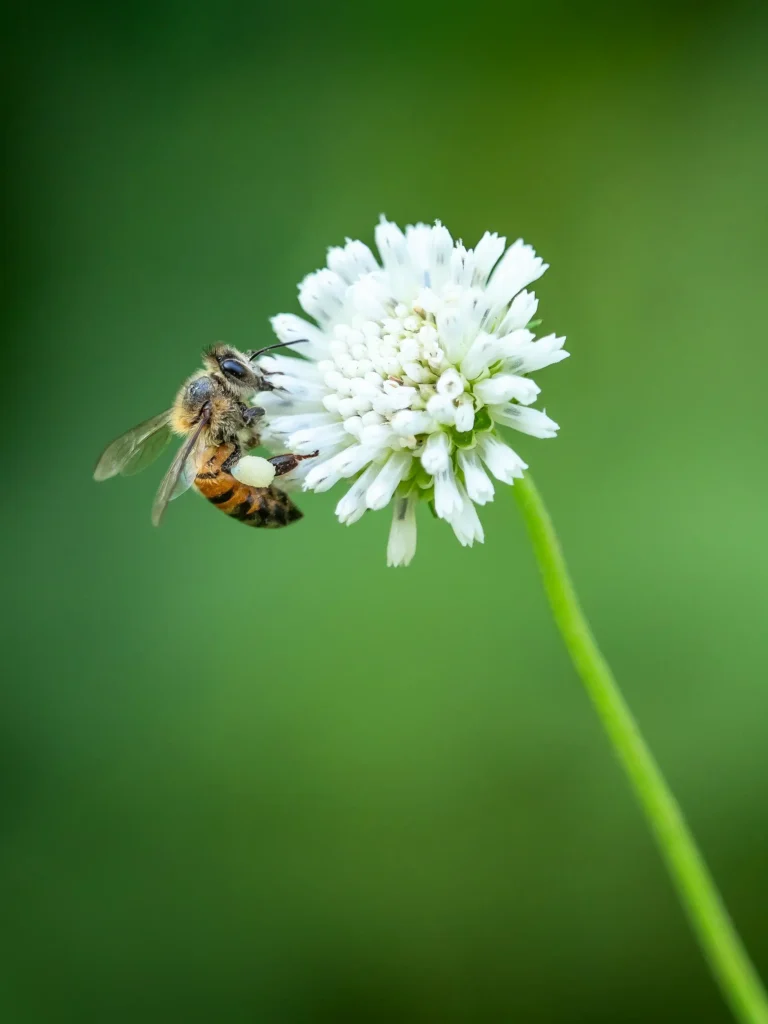
Bees play a crucial role in our ecosystem. They are the unsung heroes of pollination, ensuring the survival of various plant species, many of which we rely on for food. They don’t mean you any harm, and only sting when their life is in danger.
- Appearance: Bees are generally about half an inch long, with a robust, fuzzy body. They usually have yellow and black stripes, although the color can vary.
- Habitat: Bees are commonly found near flowers, their primary food source.
- Attraction to Humans: Bees are generally not attracted to humans unless provoked or if they feel their hive is threatened. They might also be attracted to sweet scents or bright clothing.
Fascinating Facts About Bees
Bees are social insects, living in colonies comprising a queen, workers, and drones. Their primary role is pollination, a process vital for the reproductive cycle of many plants. Without bees, the diversity of plant life, and by extension, the entire ecosystem would be at risk.
Bees communicate through a series of dances, which is a remarkable aspect of their behavior. The ‘waggle dance,’ for instance, is a way for them to communicate the location of a food source to their fellow bees. Their ability to navigate and communicate is an extraordinary example of the complexity within what may seem like simple creatures.
How to avoid Bees
- Steer Clear of Hives: Be aware of your surroundings and avoid disturbing bee hives.
- Stay Calm: If a bee is nearby, remain calm and avoid sudden movements. Bees usually sting only when they feel threatened.
- Cover Food and Drinks: Bees are attracted to sweet smells and sugars. Keep your food and drinks covered while hiking.
- Wear Neutral Colors: Bright colors can attract bees, so it’s best to wear neutral tones while hiking.
- Use Scent-Free Products: Scented lotions, perfumes, or deodorants can attract bees.
How to deal with Bee Stings
- Remove the Stinger: If you’re stung, quickly remove the stinger without squeezing the venom sac.
- Clean the Area: Wash the sting site with soap and water.
- Reduce Swelling: Apply a cold pack to reduce swelling and alleviate pain.
- Use anti-inflammatory cream: You can reduce the swelling and pain using anti-inflammatories such as anti-histamine or aloe vera gel.
- Neutralize the poison with something alkaline: Alkaline substances such as baking soda paste or toothpaste can neutralize the acidic bee venom.
- Seek Medical Attention: If you experience symptoms of an allergic reaction, use an Epipen if necessary, and seek immediate medical attention.
Bumblebees
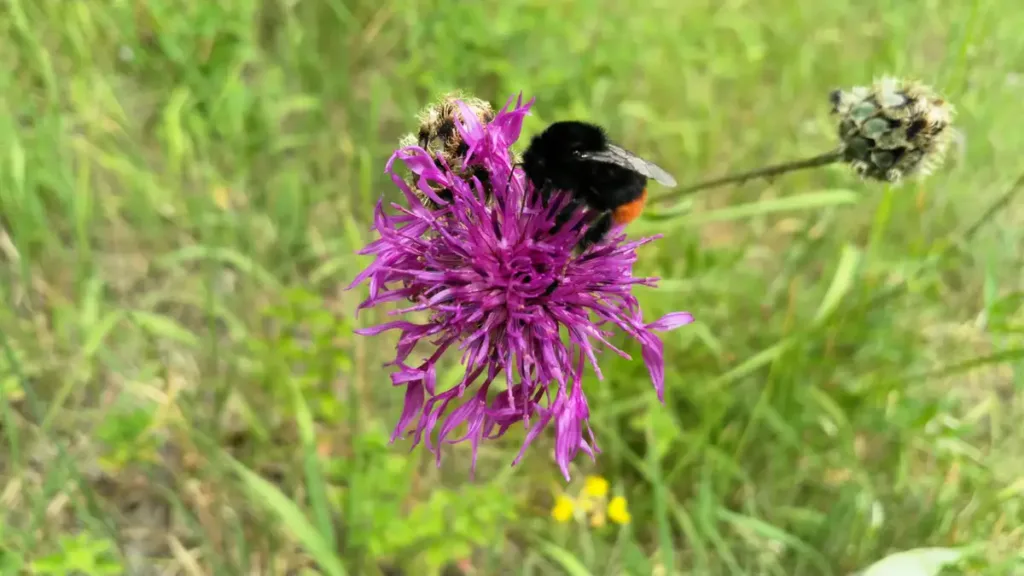
Bumblebees are a a subgroup of bees, generally much fluffier than honeybees, and very peaceful. They are able to sting repeatedly, but very rarely do, and have no interest in humans.
Wasps

Wasps are often mistaken for bees, but quite different in their personalities. Unlike bees, many wasps are predators, feeding on other insects and thus helping control pest populations.
- Appearance: Wasps have a slender body with a narrow waist, smooth skin, and typically sport yellow and black stripes with clear borders. They have much less hair than bees, and large mandibles (their claw-like mouth parts).
- Habitat: They are often found near plants, buildings, or soil where they build their nests.
How Wasps Interact with Humans
- Attraction to Humans: Wasps are mainly attracted to food or sweet drinks, but sweet-smelling hygiene products can also be at fault.
- Aggression Level: Wasps can be quite aggressive, especially if they feel their nest is threatened.
Tips for Avoiding Wasps
- Stay Away from Nests: Keep an eye out for wasp nests and maintain a safe distance. If you get stung out of nowhere, there’s probably a nest hidden nearby – move away quickly.
- Be Careful with Food: Be cautious with open food or sugary drinks which can attract wasps.
- Avoid Sudden Movements: If a wasp approaches, try to stay calm and avoid rapid movements.
- Cover your mouth & nose: When wasps fly nearby, it’s best to cover your mouth and nose, for example with a mask or buff. This way, you can’t breathe them in and get stung in your airway – swelling there could be fatal.
How to deal with Wasp Stings
- Immediate Action: If stung, wash the area with soap and water to prevent infection.
- Reducing Pain and Swelling: Apply a cold pack to the sting site.
- Use anti-inflammatory ointment: This can help reduce the swelling and pain.
- Neutralize the poison with something acidic: Wasp venom is alkaline, therefore you can neutralize it with something acidic – maybe lemon juice, apple cider vinegar, or any sour fruit you have on you.
- Allergic Reactions: Watch for signs of an allergic reaction, such as difficulty breathing, and use an Epipen and seek medical help immediately if these symptoms occur.
Hornets
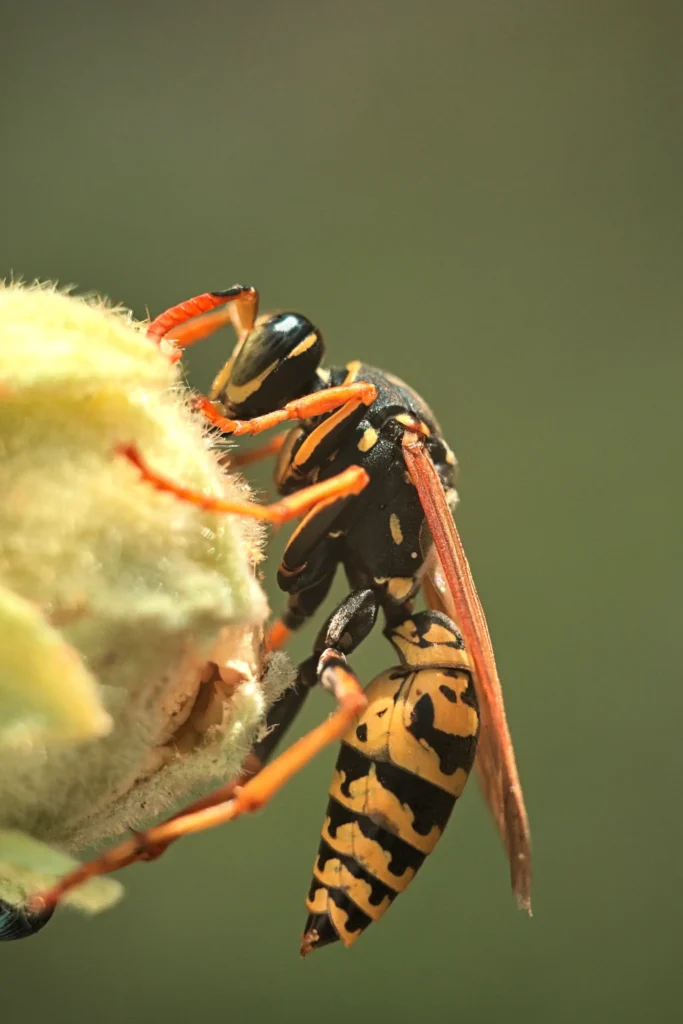
Hornets, a type of large wasp, often evoke fear due to their size and aggressive reputation. But this fear is only warranted in some regions; a lot of hornet species are actually quite calm and peaceful.
The tips for avoiding and hornets and dealing with their stings are generally the same as for the smaller wasps.
Varieties of Hornets and Their Unique Traits
Hornets display distinct behaviors and characteristics based on their species. The European hornet, for instance, is known for being less aggressive and can even be beneficial as it preys on other wasps. In contrast, certain Asian hornet species, such as the Asian giant hornet, are known for their aggressive behavior and can pose a greater risk to humans. Here’s what you need to know:
European Hornets: The Gentle Giants
- Species: Vespa crabro, commonly known as the European hornet.
- Appearance: Characterized by their size, about 1.2 inches long, with a reddish-brown head and yellow and black stripes on the body.
- Behavior: Less aggressive compared to other hornet species. They are known to prey on other insects, including wasps, and are less likely to sting humans unless their nest is directly threatened.
- Regions Found: Predominantly found across Europe and has been introduced to North America.
Asian Hornets: Varied Species with Notable Aggression
- Asian Giant Hornet (Vespa mandarinia): The largest hornet species, sometimes referred to as ‘murder hornets,’ can grow over 2 inches long. They have a striking appearance with an orange head and black and brown striped body. Known for their aggressive behavior, especially towards honeybees.
When an Asian giant hornet stings, it releases pheromones that can alert other hornets in the vicinity. These pheromones essentially act as a signal, indicating a threat or disturbance. As a result, other hornets may be drawn to the location and become more aggressive, potentially leading to a group attack. This behavior is part of their natural defense mechanism to protect their nest and colony.
However, Asian giant hornets, like many other insects, generally do not attack humans unless they feel threatened. Most incidents of multiple hornets attacking occur when a person inadvertently disturbs their nest. - Lesser Banded Hornet (Vespa affinis): Smaller than the Asian giant hornet, with a distinctive yellow band on the abdomen. They can be aggressive when their nests are disturbed.
- Oriental Hornet (Vespa orientalis): Notable for their unique reddish-brown coloration and larger size. Like other species, they can be aggressive if provoked.
- Regions Found: These species are predominantly found in Asia, with some like the Asian giant hornet having been spotted in North America recently.
Hornets in Other Regions
- North America: The European hornet is the primary species found in North America, specifically in the eastern regions.
- Australia and Africa: These continents do not have native hornet species. However, there are other types of wasps that may be mistaken for hornets.
- South America: Like Australia and Africa, South America does not have native hornet species.
Hover flies: Harmless Impostors
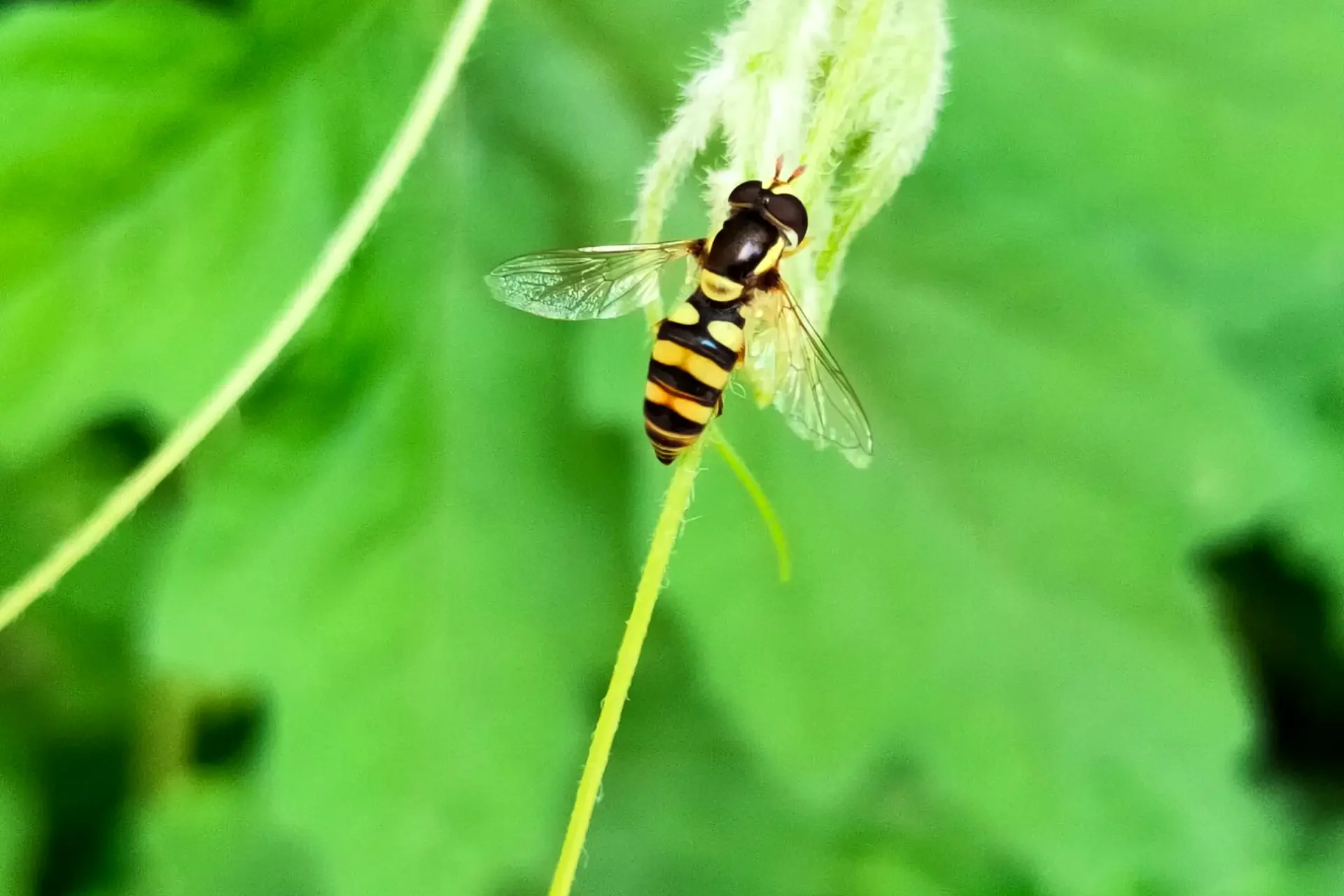
Hover flies, often mistaken for bees or wasps due to their similar appearance, are an interesting and harmless group of insects commonly encountered on hikes. These little impostors play a vital role in pollination and are a fascinating example of mimicry in nature.
They are often seen hovering around flowers, standing perfectly still in the air, then moving suddenly. What makes hoverflies unique is their mimicry; they’ve evolved to resemble more dangerous insects like wasps and bees, a survival strategy to deter predators.
- Behavior: Unlike bees and wasps, hoverflies do not sting and are generally found hovering near flowers, feeding on nectar and pollen.
- Appearance: Hoverflies can be identified by their distinctive flight patterns – they are known to hover in one spot and dart back and forth. They resemble wasps and bees but lack stingers and have a more slender, often flat body structure.
- Coloration: They typically have yellow and black stripes, mimicking the appearance of bees and wasps.
- Attraction to Humans: Hoverflies are not attracted to humans and pose no threat. They are more interested in flowers and plants.
Horseflys: Mean blood suckers
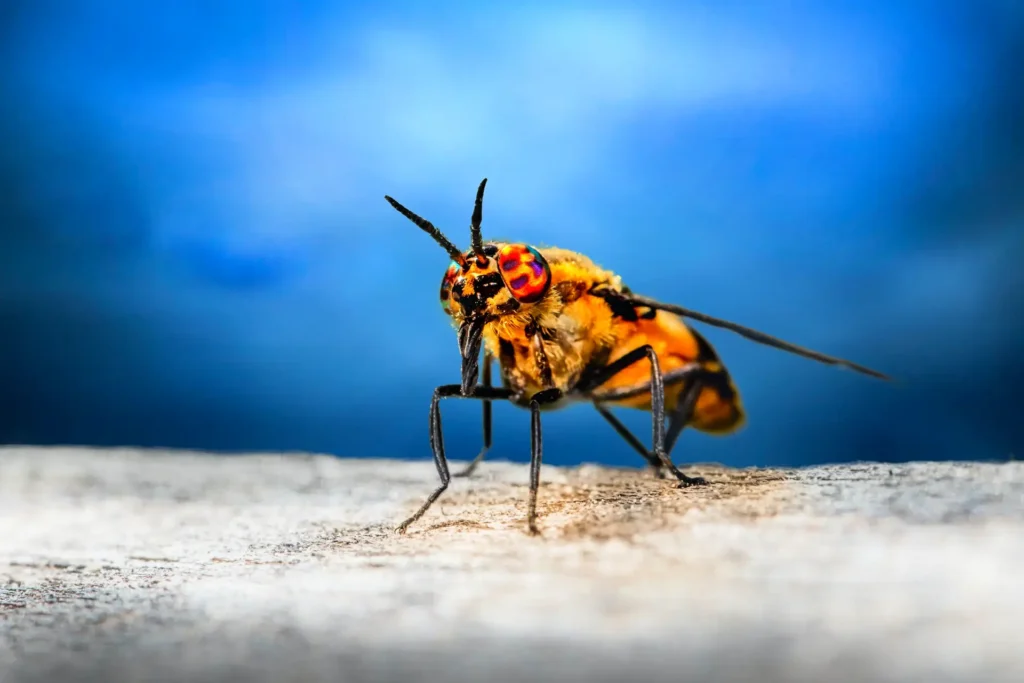
Horsefly females sting in order to drink your blood, which is quite painful.
- Appearance: Horseflys have large, colorful eyes, a very prominent stinger for a mouth, and often make a fairly loud, low-frequency flying noise.
- Habitat: They are most common in warm areas with moist breeding grounds available.
How to avoid Horseflies:
- Wear Light-Colored Clothing: These buggers are attracted to dark colors, so opt for light-colored clothing to make yourself less appealing.
- Cover Up: Wear long sleeves, pants, and a hat to minimize exposed skin.
- Use Repellent: Apply insect repellent containing DEET or picaridin to exposed areas of your skin.
- Stay Away from Water: Horseflies breed near water, so steer clear of stagnant pools and marshy areas.
- Keep Moving: These pests have a hard time biting moving targets, so stay on the move while hiking.
How to deal with Horsefly Stings:
- Clean the Area: Wash the sting site with soap and water to prevent infection.
- Apply Ice: Place an ice pack or cold compress on the sting to reduce swelling and pain.
- Topical Creams: Over-the-counter hydrocortisone creams can help with itching and inflammation.
- Antihistamines: Take an oral antihistamine like Benadryl to relieve itching and discomfort.
- Pain Relief: Over-the-counter pain relievers like ibuprofen can help with pain and swelling.
- Watch for Infection: Keep an eye on the sting for signs of infection, such as redness, pus, or increased pain.
Environmental Considerations
While protecting oneself from insects is important, it’s equally important to consider the ecological impact of our actions. Responsible use of insect repellents and awareness of the broader environmental context can help preserve ecosystems and the important role insects play in them.
The Ecological Role of Insects and Responsible Insect Repellent Use
Insects are vital to many ecosystems. They pollinate plants, decompose organic matter, and serve as a food source for other wildlife. When using insect repellents, choose products that are effective but have minimal environmental impact. Biodegradable, non-toxic repellents are preferable. Additionally, applying repellent sparingly and only when necessary can reduce potential harm to the environment.
Avoid Harming Aquatic Life and Ecosystems
Many insect repellents, especially those with DEET, can be harmful to aquatic life if they enter waterways. When hiking near streams, lakes, or other bodies of water, be mindful of this and avoid using excessive amounts of repellent. Consider physical barriers like clothing or nets as alternatives near sensitive aquatic areas.
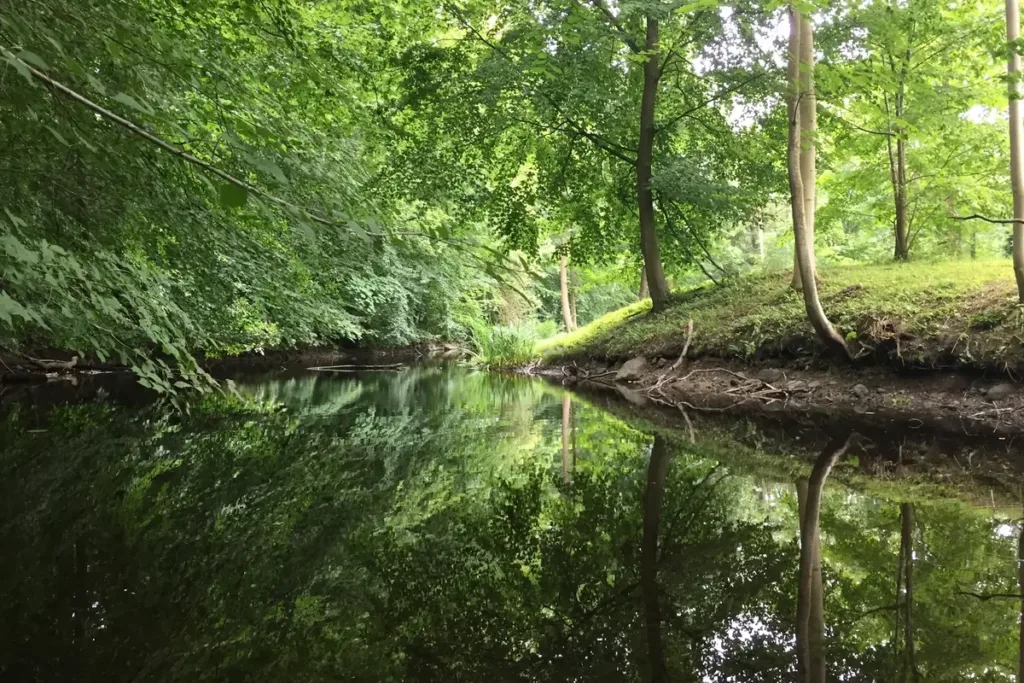
Conclusion
From the pollinating bees and diverse wasp species to the formidable hornets, each plays a unique role in the ecosystem. By learning about their behaviors, habitats, and how to identify them, we can better prepare for and manage any interactions.
Dressing appropriately, using scent-free products, and being mindful of our surroundings can significantly reduce the chances of unwanted encounters. In the rare event of a sting or bite, knowing the basics of first aid and when to seek medical help is vital.
Bees, wasps and hornets only sting defensively, if you stay calm and give them space – and stay away from their hives – they won’t harm you.

